
Neoboletus luridiformis, also previously known as Boletus luridiformis and (invalidly) as Boletus erythropus, is a fungus of the bolete family, all of which produce mushrooms with tubes and pores beneath their caps. It is found in Northern Europe and North America, and is commonly known as the scarletina bolete, for its red pores. Other common names is: red foot bolete, dotted stemmed bolete, dotted stem bolete.

William Alphonso Murrill was an American mycologist, known for his contributions to the knowledge of the Agaricales and Polyporaceae. In 1904, he became the assistant Curator at the New York Botanical Garden (NYBG). He, along with the NYBG, founded the journal Mycologia and was its first editor for 16 years. Murrill was known to travel extensively to describe the mycota of Europe and the Americas. He traveled along the East Coast, Pacific Coast, Mexico and the Caribbean. Although Murrill was a very influential person at the NYBG, having worked his way up to become assistant director in 1908, his rather eccentric personality caused problems with his job. He went on annual collecting trips to Mexico, the Caribbean, Europe, and South America, sometimes, without informing any of his colleagues prior. These trips resulted in a cumulative total of 70,000 specimens, 1,400 of which are deposited in the NYBG.
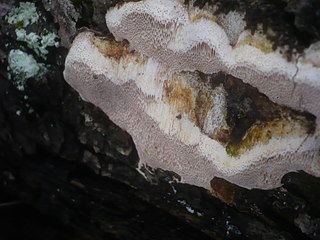
Perenniporia is a cosmopolitan genus of bracket-forming or crust-like polypores in the family Polyporaceae. They are dimitic or trimitic with smooth, thick-walled basidiospores and cause a white rot in affected wood.

Suillellus luridus, commonly known as the lurid bolete, is a fungus of the family Boletaceae, found in calcareous broadleaved woodlands in Europe. Fruit bodies appear in summer and autumn and may be locally abundant. It is a firm bolete with an olive-brown cap up to 20 cm (8 in) in diameter, with small orange or red pores on the underside. The stout ochre stem reaches 8–14 cm (3–6 in) high and 1–3 cm (0.4–1.2 in) wide, and is patterned with a red network. Like several other red-pored boletes, it stains blue when bruised or cut.

Pulveroboletus is a genus of fungi in the family Boletaceae. The genus has a cosmopolitan distribution and contains 41 species.

Tyromyces is a genus of poroid fungi in the family Polyporaceae. It was circumscribed by mycologist Petter Karsten in 1881. The type species is the widely distributed Tyromyces chioneus, commonly known as the white cheese polypore. The phylogenetic position of Tyromyces within the Polyporales is uncertain, but it appears that it does not belong to the "core polyporoid clade". Tyromyces is polyphyletic as it is currently circumscribed, and has been described as "a dumping place for monomitic white-rot species with thin-walled spores."
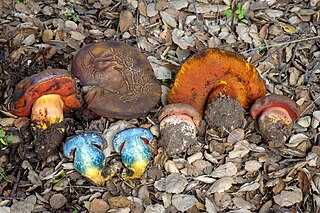
Suillellus amygdalinus is a fungus of the bolete family found in western North America. The fruit bodies, or mushrooms, are characterized by their thick, red to brown caps, red pores, and the strong bluing reaction observed when the mushroom tissue is injured or cut. The cap can reach diameters of up to 12 cm (4.7 in) and the stipe 9 cm (3.5 in) long by 3 cm (1.2 in) thick at maturity. This mushroom has been found in manzanita and madrone woodlands of central California north to southern Oregon. Although the edibility of the mushroom is not known with certainty, it may be poisonous, and is not recommended for consumption. Other similar red-pored, bluing boletes from North America, including Rubroboletus eastwoodiae, Boletus luridiformis, and B. subvelutipes, can be distinguished from S. amygdalinus either by the color of the cap, the degree of reticulation on the stipe, or by location.
Pluteus brunneidiscus is a species of agaric fungus in the family Pluteaceae. It was first described scientifically by American mycologist William Alphonso Murrill in 1917. It is found in Europe (Spain) and North America.
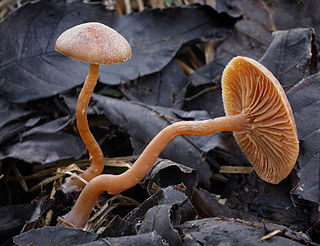
Tubaria is a genus of fungi in the family Tubariaceae. The genus is widely distributed, especially in temperate regions. Tubaria was originally named as a subgenus of Agaricus by Worthington George Smith in 1870. Claude Casimir Gillet promoted it to generic status in 1876. The mushrooms produced by species in this genus are small- to medium-sized with caps ranging in color from pale pinkish-brown to reddish-brown, and often with remnants of the partial veil adhering to the margin. Mushrooms fruit on rotting wood, or, less frequently, in the soil. There are no species in the genus that are recommended for consumption.

Suillellus queletii, commonly known as the deceiving bolete, is an uncommon, edible mushroom in the genus Suillellus.
Neoboletus sinensis, known until 2014 as Boletus sinensis, is a species of bolete fungus in the family Boletaceae native to Hainan province in China. It is closely related to, and was previously considered a form of, Suillellus luridus. It was transferred to the new genus Neoboletus in 2014.

Amanita wellsii or the salmon amanita is a species of agaric fungus in the family Amanitaceae. It was described by American mycologist William Alphonso Murrill in 1920, based on collections made in Springfield, New Hampshire in 1917. The specific epithet honors Professor H. L. Wells, who had previously studied the species.

Limacella glischra is a mushroom species in the family Amanitaceae. It was first named as a species of Lepiota by Andrew Price Morgan in 1906; William Alphonso Murrill transferred it to Limacella in 1914.
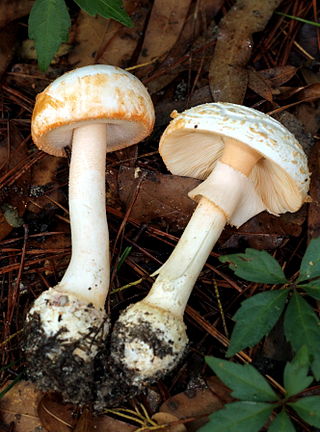
Amanita roseotincta is a species of agaric fungus in the family Amanitaceae found in North America. It was first described by American mycologist William Alphonso Murrill in 1914 as a species of Venenarius before being transferred to Amanita the same year.

Suillellus is a genus of bolete fungi in the family Boletaceae. It was originally described by William Alphonso Murrill in 1909 with Suillellus luridus as the type species. The genus was later sunk into synonymy with Boletus, but eventually resurrected in 2014, after molecular phylogenetics research demonstrated that Suillellus species comprised a different lineage than Boletus.
Suillellus adonis is a species of bolete fungus described from Croatia. Originally described as a species of Boletus in 2002, it was transferred to Suillellus in 2014, based on melacular phylogenetic data. This apparently rare fungus is so far known only from the islands of Cres and Cyprus.
Suillellus atlanticus is a species of bolete fungus found in coastal sand dunes in Galicia. Originally described as a species of Boletus in 2013, it was transferred to Suillellus the following year.
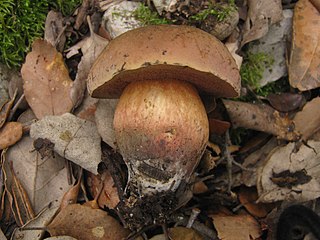
Suillellus comptus is a species of bolete fungus found in Europe. Originally described as a species of Boletus in 1993, it was transferred to Suillellus in 2014.
Suillellus hypocarycinus is a species of bolete fungus found in North America. Originally described as a species of Boletus by Rolf Singer in 1945, it was transferred to Suillellus by William Alphonso Murrill in 1948.

Suillellus mendax is a species of bolete fungus found in Europe. It was originally published as a species of Boletus when it was newly described in 2013, but then transferred to Suillellus the following year.













